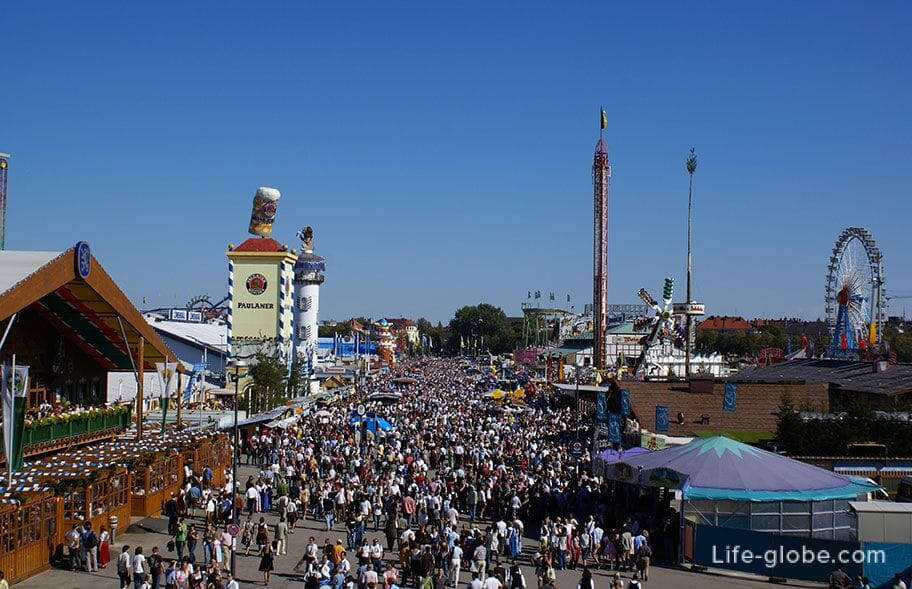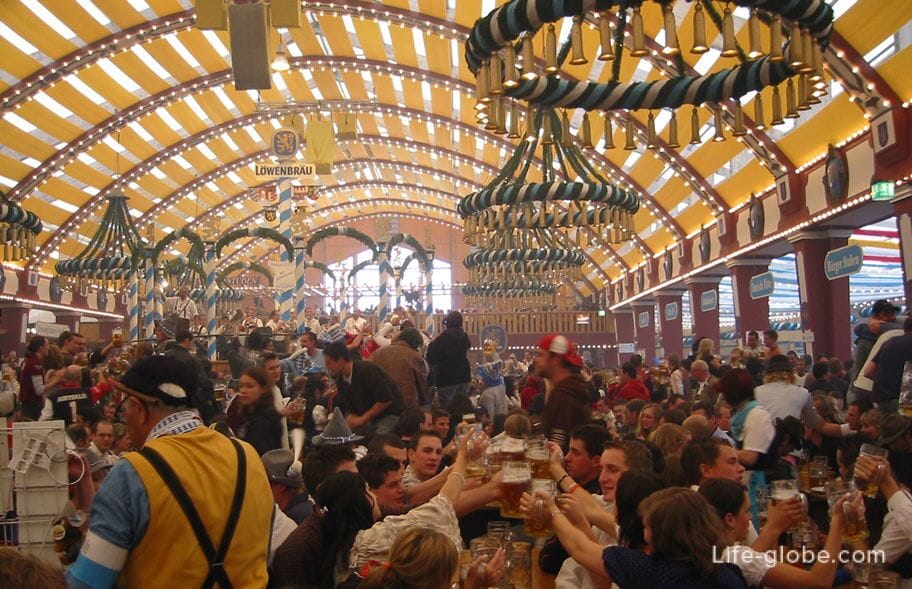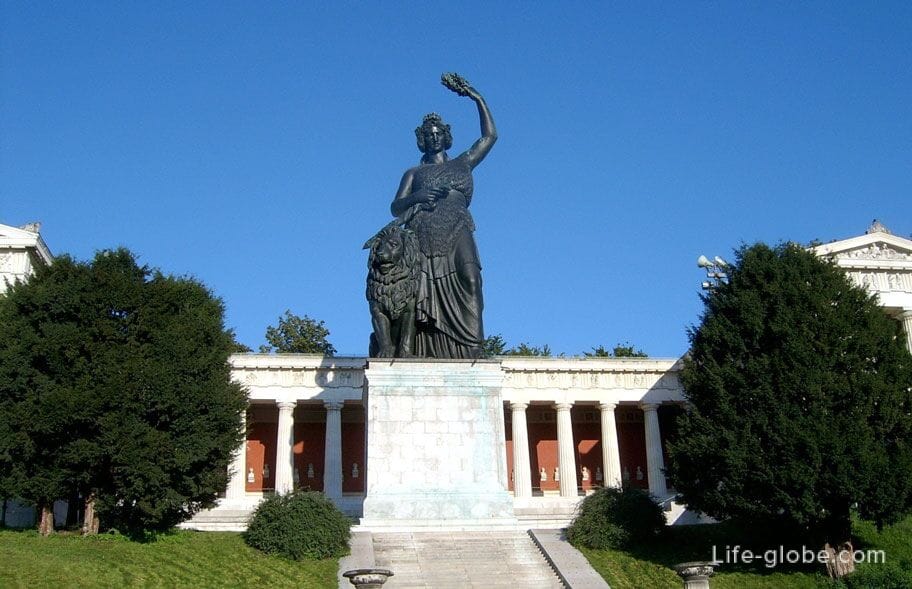
In 2023, Oktoberfest will run from September 16th to October 3rd. Hotels in Munich
In this article we will talk about the Oktoberfest festival and its history.

Oktoberfest (German name: Oktoberfest) is the world's largest, most famous and most visited folklore festival or "beer festival".
Oktoberfest means the October festivities, also known among the Munich people themselves under the name "Wiesn" in the Bavarian dialect meaning meadow. They call it the meadow, because from time immemorial, the walk takes place in the center of Munich on Therese Meadow, not far from the main station cities. From the station 10-15 minutes on foot.

The festival is held annually, from mid-September to early October. Every year the dates of the festival vary, so those wishing to attend this event should inquire about the dates in advance. Its duration is on average 16-17 days.
In 2023, Oktoberfest will run from September 16th to October 3rd.
All accommodation facilities in Munich (hotels, apartments, houses, etc.) can be view and book here
More than 6 million guests visit the festival every year.
The main features of the holiday are a large number of beer tents and smaller tents, with a capacity of up to 10 thousand people each, as well as a variety of fair rides and street stalls with beer, souvenirs, snacks, sausages, shank and other Munich delicacies.
Oktoberfest is organized and hosted by the City of Munich. Only Munich breweries are allowed to participate in this festival, which brew for it a special Oktoberfest beer (Oktoberfestbier) with an alcohol content of 5.8 to 6.3%, which at other times of the year is usually called March or Vienna.
On weekdays, beer is poured in tents from 10 am to 10:30 pm. On weekends, you can taste Munich beer at Oktoberfest as early as 9 am.
The Oktoberfest presents Bavarian brands of beer, each of which is a separate topic for beer gourmets. Trying them all in one visit, of course, is unlikely to succeed - you will have to return to the festival again. But this is even better, because you want to visit such an event again and again.
What beer can be tasted at the festival
Augustiner and Paulaner are some of the most popular in Germany, Spaten-Franziskaner is probably one of the most popular beer brands among local residents, as well as: Löwenbräu, Hacker-Pschorr, Hofbräu, etc. Depending on the year, certain brands and beers may not be present at the celebration or supplemented.
Each type of beer can be tasted in your tent. We mostly hung out in a tent with our favorite beer - Paulaner. All tents close at 23:30, except Käfer Wiesn-Schänke and Kufflers Weinzelt Weinzelt, which are open until 1:00 a.m. and stop serving beer at 00:30. We recommend that you check this information in advance, because every year everything can change.
Places in tents can be booked in advance, but, as a rule, free places before 17:00 can always be easily found. But after 17:00 the most fun begins, with music and dancing, and then most often you can’t get into the tents.
For the convenience of visitors, the Oktoberfest introduced the so-called beer brands (in German Biermarken), which can be obtained in each individual tent by ordering stamps by phone. Unused stamps can be exchanged for beer after the holiday at various Munich beer gardens.
By the way, in Bavaria there is a law on the purity of beer - Reinheitsgebot (German: Reinheitsgebot, that is, a requirement for purity. The purity of the unchanged Bavarian beer). This law regulates the production of beer in Germany. According to the original text of the document, only three ingredients should be used to produce beer: water, barley (barley malt) and hops. The law was issued in the city of Ingolstadt (Duchy of Bavaria) on April 23, 1516. This law established rules for the production and trade of beer. Since 1906, the Reinheitsgebot has been extended to the entire territory of the German Empire and enshrined in the beer tax law (German: Biersteuergesetz (BierStG).
All 16 days of celebration, and most importantly, drinking beer, are accompanied by a rich show program: costumed parades, processions of shooters, horse races, successive concerts. Near the beer tents, you can often see dancers in traditional Bavarian costumes tapping "schuplattl" with heavy alpine boots.
The so-called discount days of the holiday are also held, for example, you can save a little on attractions every Tuesday during the festival, from 10 am to 7 pm. On the Days of the Family, the unchanging carousels, on which the festival has been inviting to ride for more than 80 years, and modern attractions - a roller coaster with a dead loop 1,300 meters long, or a 60-meter free fall tower, are especially in demand. We rode on these rides, it should be noted - an unforgettable experience, although after 3-5 mugs of beer, feelings become dull)). By the way, the volume of beer at Oktoberfest is only liter mugs. Children will probably especially enjoy the 50-meter-high Ferris wheel and, of course, Bavarian cotton candy, gingerbread and roasted almonds.
The history of Oktoberfest began on October 12, 1810. The celebration took place in honor of the marriage of Crown Prince Ludwig (later King Ludwig I) and Princess Therese of Saxony-Hildburghausen. It is her name that the meadow where the holiday takes place is named. All residents of the city were invited to the celebration. In honor of the wedding on October 17, horse races were also arranged. For this reason, different sources give different dates for the first Oktoberfest - 12 and 17 October.
In 1813, the holiday did not take place, since at that time Bavaria was involved in the Napoleonic Wars.
Initially, the holiday was organized and held privately. In 1819, the organization and management of the festival was placed in the hands of the city council of Munich. It was decided that Oktoberfest would be held every year without exception. After that, the festival began to be celebrated annually. Over time, the festival became more and more large-scale in celebration, people from all over the country, and then the whole world, learned about it and visited it.
In 1850-1853, a complex ensemble appeared on Theresa's meadow, consisting of the statue "Bavaria", in the head of which there is an observation deck and a hall of fame created by Ludwig Michael Schwantaler and Lev von Klenze. More about the Bavaria Statue and Hall of Fame...

In various sources you can find out about the nuances of the Oktoberfest. While preparing for the trip, we also used this information, but ... I must say, we have already learned about the truthfulness of such information from our own experience, and this truth turned out to be completely different. About this you can read here.
Oktobefest website, where you can find all the necessary information about the festival: oktoberfest.de.